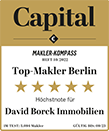Real Estate Pankow
People strolling along Kastanienallee, across the Kollwitzplatz and through the adjoining streets on a beautiful summer day, enjoy the broad, clean pavements, the true-to-detail renovated and freshly painted art nouveau pearls, the hip new buildings, the many trees and the young people. They sit everywhere in picturesque street cafés, sipping Latte Macchiato or Bionade, read, argue with their kids and stare at MacBooks, iPads or smart phones. People looking for peace in a green environment go to the idyllic Mauerpark where they can still find some colourfully painted remains of the Berlin Wall.
Some years ago, the magazine ‘Die Zeit’ described the new attitude towards life in the Prenzlauer Berg quarter, which is part of the Pankow district, as the culture of “Bionade-Biedermeier”. Hard to believe that “Prenzlberg”, as the newcomers like to call it, used to be a poor quarter back then when the wall came down. Many of the old buildings were dilapidated, often vacant and all completely unrenovated. But the quarter woke up from its deep slumber when Germany’s largest coherent Gründerzeit quarter was declared a redevelopment area at the beginning of the 1990s and the buildings were renovated one after the other. This change did not go unnoticed: creative people, artists, students – those who could, moved here. Clubs, cafés, small designer stores, bio-markets, yoga studios emerged. The quarter changed radically.
Estimates state that the 80 percent of the population has been replaced since the turnaround. About 50 percent of the residents are between 25 and 45 years old, most of them are academics, educated, well-off. The prices have gone higher, but the demand is undiminished. More than 150,000 people live in Pankow by now.
The adjoining quarters of Pankow and Weißensee therefore benefit from the boom of the trendy quarter. In the recent past, the demand for residential space increased here too and rents and purchase prices are rising. But life is comparably affordable with similar good conditions. The infrastructure is above average, the population is well-to-do, the connections to the city are excellent. Weißensee offers green oases around the Orankesee and the Obersee lakes. Pankow has two spacious local recreation areas to offer with the Bürgerpark and the Volkspark Schönholzer Heide. There is even a children’s farm: the bigger kids help feeding and tending the livestock and the little ones watch and pet the animals and so experience nature in the middle of the city.
Even those who are really drawn out into the nature are at the right place in the Pankow district, which includes a total of 13 quarters. The quarters Niederschönhausen, Heinersdorf, Karow, Rosenthal, Wilhelmsruh, Französisch Buchholz and Buch for instance, situated to the north and east of Pankow, offer, for the most part, only a few tenement buildings, but extensive single-family and townhouse quarters instead. And moreover, they can be easily reached with public transportation. Life is really rural in Blankenfelde. Surrounded by fields, people live a tranquil life in the country in this most sparsely populated quarter of Berlin. Only 155 inhabitants live on one square kilometre here. Hard to believe that on the other end of the district a total of 14,307 people share a square kilometre in the southern part of Prenzlauer Berg. Life cannot be more different within a single district.

 Back
Back 







